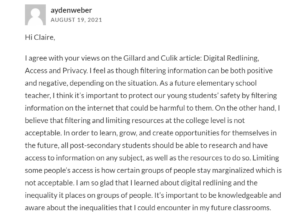Link to original blog post (topic 3):
https://tobiandcookie.opened.ca/topic-3-discussion-post/
Updated version :
I’ve never fully considered how home literacy practices can impact successful literacy learning at school, but after the readings, I was able to apply it to my own experiences. My mother signed me up for extracurriculars and bought additional homework books from the bookstore (which were typically Math, English, and/or French) that I was to complete once every few days. Although I hated the extra homework at the time, I found that being disciplined in that way made my work habits more efficient once I was actually at school. Since at-home literacy was a common activity for me, it seemed less like an instructed process and more like an enjoyable, familiar activity. Like Kral and Schwab’s article discusses, it’s important that marginalized groups are provided with supportive resources where independent learning can be accessed. Not having access to digital technologies was one factor I have assumed would put an individual at a learning disadvantage, but I did not previously realize the extent of how other aspects mentioned in the article, such as spatial control, play an extensive roles in our lives. Spatial control effects how people can feel in a public environment. Feelings of discomfort and a sense of disempowerment and marginalization will prevent groups from comfortably accessing areas that facilitate learning, such as libraries, youth centers, media centers, public computers, etc. (Kral & Schwab, 2012). And these public spaces are so important because home literacy practices may be difficult in certain households, and these people rely on external resources to support their learning.
Gilliard’s article made me reflect on how much information is limited because of the filters on web-based resources. On one hand, it filters out potentially harmful and inappropriate web searches, but just like the example of the student attempting to undergo research on revenge porn (which is an extremely relevant issue), when certain topics are being researched for educational and good-intentioned purposes, these blocks become unhelpful because they limit our knowledge on significant matters. For elementary schools, these filters are necessary to protect young children from harmful information on the internet. However, with post-secondary level institutions, I think schools should continue to be aware of how digital redlining may introduce possible discrimination/biases that create learning inequities by filtering information that would otherwise be beneficial to those disadvantaged groups.
Description of changes:
- I deleted some parts about my personal experience with at home literacy because I felt it did not fully contribute to the topic and was unnecessary, so I shortened it.
- the part on spatial control I added on was from my digital profile because the way I summarized it was more informative on the point I was attempting to make.
- I clarified my point on redlining because of the comments from my discussion post. I liked how Ayden thought it was necessary to filter out certain information for young children, so I incorporated that into my own statement. Here is Ayden’s comment:

References:
Kral, I. & Schwab, R.G. (2012). Chapter 4: Design Principles for Indigenous Learning Spaces. Safe Learning Spaces. Youth, Literacy and New Media in Remote Indigenous Australia. ANU Press. http://doi.org/10.22459/LS.08.2012
Leave a Reply